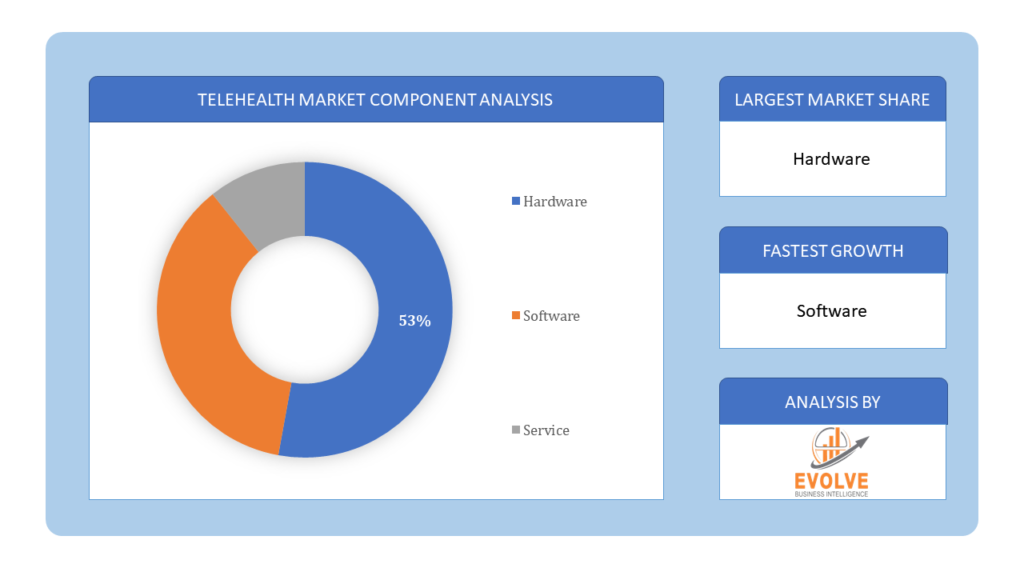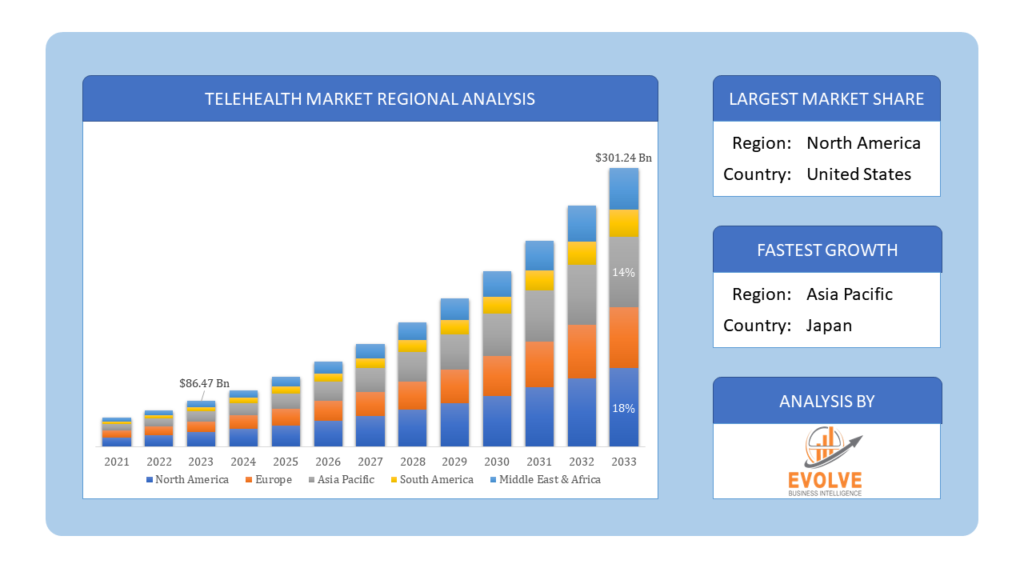Global Telehealth Market Overview
The Global Telehealth Market Size is expected to reach USD 301.24 Billion by 2033. The Global Telehealth Market industry size accounted for USD 86.47 Billion in 2023 and is expected to expand at a compound annual growth rate (CAGR) of 23.87% from 2023 to 2033. The Global Telehealth Market refers to the collective market for telehealth services and technologies on a worldwide scale. Telehealth encompasses the use of digital communication and information technologies, such as video conferencing, mobile apps, remote monitoring devices, and other telecommunications tools, to deliver healthcare remotely. It enables patients to access medical care, consultations, monitoring, and educational resources from healthcare professionals without the need for in-person visits to healthcare facilities.
Factors driving the growth of the global telehealth market include advancements in technology, increasing adoption of telehealth solutions by healthcare providers and patients, rising healthcare costs, and the need for remote healthcare access, especially in underserved or remote areas. The global telehealth market is characterized by a wide range of services and applications, including telemedicine, remote patient monitoring, teleconsultation, telepsychiatry, teledermatology, and others. It serves various medical specialties and healthcare settings, including hospitals, clinics, nursing homes, and home healthcare.
Global Telehealth Market Synopsis
The COVID-19 pandemic had a significant impact on the global telehealth market. With lockdowns, social distancing measures, and concerns about virus transmission, there has been a surge in demand for remote healthcare services. Telehealth provides a safe and convenient way for patients to receive medical care without the need for in-person visits, reducing the risk of exposure to COVID-19. Healthcare providers rapidly expanded their telehealth offerings to meet the growing demand and accommodate patients who were unable or unwilling to visit healthcare facilities in person. This expansion included the implementation of telemedicine consultations, remote monitoring solutions, virtual appointments, and telepsychiatry services. The pandemic prompted accelerated adoption of telehealth technologies among healthcare providers and patients. This increased adoption led to greater investment in telehealth infrastructure, software platforms, and digital health solutions. Additionally, there was a surge in innovation as companies developed new telehealth tools and services to address the specific needs of patients and healthcare providers during the pandemic.
Global Telehealth Market Dynamics
The major factors that have impacted the growth of Global Telehealth Market are as follows:
Drivers:
Ø Technological Rising Chronic Disease Prevalence
The global prevalence of chronic diseases such as diabetes, cardiovascular diseases, and respiratory conditions is on the rise. Telehealth enables continuous monitoring and management of chronic conditions through remote patient monitoring devices and virtual consultations, allowing healthcare providers to deliver timely interventions and support to patients. Advances in technology, including high-speed internet connectivity, mobile devices, wearable sensors, and telecommunication infrastructure, have significantly improved the feasibility and effectiveness of telehealth solutions. These technological advancements enable seamless communication between patients and healthcare providers, real-time monitoring of patient health metrics, and the integration of telehealth into existing healthcare systems. Telehealth has the potential to reduce healthcare costs by minimizing the need for in-person visits, hospital readmissions, and unnecessary emergency room visits. By enabling early detection of health issues, proactive management of chronic conditions, and timely interventions, telehealth can improve healthcare outcomes while reducing overall healthcare spending.
Restraint:
- Privacy and Security Concerns
Despite advancements in technology, there remains a digital divide, with disparities in internet access, digital literacy, and access to devices such as smartphones and computers. Individuals in rural or underserved areas, older adults, and low-income populations may face barriers to accessing telehealth services, limiting the reach and effectiveness of telehealth initiatives. Telehealth involves the transmission and storage of sensitive patient health information over digital networks, raising concerns about data privacy and security. Healthcare organizations must comply with strict regulations, such as HIPAA in the United States, to ensure the confidentiality and integrity of patient data. Addressing these privacy and security concerns requires robust cybersecurity measures, which can be resource-intensive and costly.
Opportunity:
⮚ Expansion of Remote Monitoring Solutions
With the proliferation of wearable devices and Internet of Things (IoT) technology, there is an opportunity to expand remote monitoring solutions for various health conditions. Remote monitoring devices can track vital signs, medication adherence, and disease-specific metrics, enabling proactive management of chronic conditions and early detection of health issues. There is a growing demand for mental health services worldwide, and telehealth offers an opportunity to expand access to mental health care through virtual consultations, therapy sessions, and remote monitoring of mental health metrics. Telepsychiatry and telemental health services can reach individuals in underserved areas, reduce stigma associated with seeking mental health treatment, and provide more convenient and flexible care options.
Global Telehealth Market Segment Overview
By Component
 Based on Component, the market is segmented based on Hardware, Software and Service. The services segment dominant the market and has large share. This large share is attributed to the increased adoption of telehealth services to manage chronic conditions, monitor health combined with advancements in digital healthcare infrastructure.
Based on Component, the market is segmented based on Hardware, Software and Service. The services segment dominant the market and has large share. This large share is attributed to the increased adoption of telehealth services to manage chronic conditions, monitor health combined with advancements in digital healthcare infrastructure.
By Delivery Mode
Based on Delivery Mode, the market segment has been divided into the Web-based, Cloud-based and On-Premise. The web-based delivery segment dominated the market. Factors such as rising adoption of web-based solutions by the healthcare professionals as well as patients to access healthcare services positively impacted the market growth.
By End User
Based on End User, the market segment has been divided into the Provider, Payer, Patient and Others. The provider segment dominated the market, due to increasing adoption of teleconsultation, telemedicine, and telehealth among healthcare professionals to reduce burden on healthcare facilities.
Global Telehealth Market Regional Analysis
Based on region, the global Telehealth Market has been divided into North America, Europe, Asia-Pacific, the Middle East & Africa, and Latin America. North America is projected to dominate the use of the Telehealth Market followed by the Asia-Pacific and Europe regions.
 Telehealth North America Market
Telehealth North America Market
North America holds a dominant position in the Telehealth Market. North America, particularly the United States and Canada, has been a leader in telehealth adoption. Factors driving growth in this region include advanced healthcare infrastructure, supportive regulatory policies, reimbursement mechanisms for telehealth services, and high levels of internet penetration. The COVID-19 pandemic further accelerated telehealth adoption in North America, with increased reimbursement rates and relaxed regulatory restrictions. Telehealth platforms offer a wide range of services, including telemedicine consultations, remote monitoring, and virtual care for chronic conditions.
Telehealth Asia-Pacific Market
The Asia-Pacific region has indeed emerged as the fastest-growing market for the Global Telehealth Market industry. The Asia-Pacific region is witnessing rapid growth in telehealth adoption, driven by factors such as increasing smartphone penetration, expanding internet connectivity, and growing healthcare demand. Countries like China, India, and Australia are investing in telehealth infrastructure to address healthcare access disparities, improve healthcare delivery in rural areas, and manage the burden of chronic diseases. Telehealth platforms in Asia-Pacific offer a wide range of services, including telemedicine consultations, telepsychiatry, and remote monitoring of vital signs.
Competitive Landscape
The global Telehealth Market is highly competitive, with numerous players offering a wide range of software solutions. The competitive landscape is characterized by the presence of established companies, as well as emerging startups and niche players. To increase their market position and attract a wide consumer base, the businesses are employing various strategies, such as product launches, and strategic alliances.
Prominent Players:
- Philips Healthcare
- Medtronic PLC
- Honeywell Life Care Solutions
- Tunstall Healthcare
- Care Innovations
- Cerner Corporation
- Medvivo Group Ltd.
- Globalmedia Group LLC
- Aerotel Medical Systems Ltd.
- AMD Global Telemedicine Inc.
Scope of the Report
Global Telehealth Market, by Component
- Hardware
- Software
- Service
Global Telehealth Market, by Delivery Mode
- Web-based
- Cloud-based
- On-Premise
Global Telehealth Market, by End User
- Provider
- Payer
- Patient
- Others
Global Telehealth Market, by Region
- North America
- US
- Canada
- Mexico
- Europe
- UK
- Germany
- France
- Italy
- Spain
- Benelux
- Nordic
- Rest of Europe
- Asia Pacific
- China
- Japan
- South Korea
- Indonesia
- Austalia
- Malaysia
- India
- Rest of Asia Pacific
- South America
- Brazil
- Argentina
- Rest of South America
- Middle East & Africa
- Saudi Arabia
- UAE
- Egypt
- South Africa
- Rest of Middle East & Africa
| Parameters | Indicators |
|---|---|
| Market Size | 2033: $301.24 Billion |
| CAGR | 23.87% CAGR (2023-2033) |
| Base year | 2022 |
| Forecast Period | 2023-2033 |
| Historical Data | 2021 |
| Report Coverage | Revenue Forecast, Competitive Landscape, Growth Factors, and Trends |
| Key Segmentations | Component, Delivery Mode, End User |
| Geographies Covered | North America, Europe, Asia-Pacific, Latin America, Middle East, Africa |
| Key Vendors | Philips Healthcare, Medtronic PLC, Honeywell Life Care Solutions, Tunstall Healthcare, Care Innovations, Cerner Corporation, Medvivo Group Ltd., Globalmedia Group LLC, Aerotel Medical Systems Ltd. And AMD Global Telemedicine Inc |
| Key Market Opportunities | • Expansion of Remote Monitoring Solutions Virtual Care for Mental Health Servicess |
| Key Market Drivers | • Rising Chronic Disease Prevalence • Technological Advancements |
REPORT CONTENT BRIEF:
- High-level analysis of the current and future Telehealth Market trends and opportunities
- Detailed analysis of current market drivers, restraining factors, and opportunities in the future
- Telehealth Market historical market size for the year 2021, and forecast from 2023 to 2033
- Telehealth Market share analysis at each product level
- Competitor analysis with detailed insight into its product segment, Government & Defense strength, and strategies adopted.
- Identifies key strategies adopted including product launches and developments, mergers and acquisitions, joint ventures, collaborations, and partnerships as well as funding taken and investment done, among others.
- To identify and understand the various factors involved in the global Telehealth Market affected by the pandemic
- To provide a detailed insight into the major companies operating in the market. The profiling will include the Government & Defense health of the company’s past 2-3 years with segmental and regional revenue breakup, product offering, recent developments, SWOT analysis, and key strategies.







